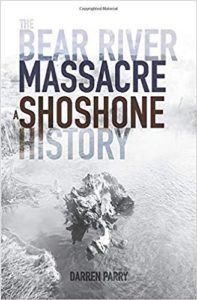 Title: The Bear River Massacre: A Shoshone History
Title: The Bear River Massacre: A Shoshone History
Author: Darren Parry
Publisher: BCC Press
Genre: History
Year Published: 2019
Number of Pages: 165
Binding: Paper
Price: $9.95
Reviewed by Rachel Rueckert
This powerful book by Darren Parry—historian, Chairman of the Northwestern Band of the Shoshone Nation, and a sixth-generation Shoshone-Latter-day Saint—should be required reading for all Latter-day Saints (and anyone who claims Mormon or Utah pioneer heritage).
Today—January 29—marks 160 year since the Bear River Massacre. Parry is a direct descendent of Sagwich, a chief during this brutal murder at Bear River (a river known as Boa Ogoi to the Native people). The Bear River Massacre, though “largely forgotten” according to Parry, “was the largest massacre of Native peoples in the history of the United States.” Four hundred innocent people, including women and children, were slaughtered by Patrick Edward Connor’s band of U.S. military men. Connor was then promoted by the U.S. government for his efforts (graduating from merely babysitting the Mormons); he retired peacefully with honors and died at a ripe old age.
Parry shows the opposite trajectory for Sagwich and the few remaining in his tribe. Not only does Parry include essential stories and details passed down from his ancestors from that horrific event, but he also shows what became of the people in the time afterward. The history is fascinating and nuanced. Sagwich and his people face extreme challenges. They also largely convert to the Latter-day Saint faith (I found it striking that baptisms happened in the same river of the terrible slaughter). The relationship between these two identities (Indigenous and Mormon) fascinated me, teaching me not only more about this infamous massacre, but about how this tribe survived and who they are today despite harmful treatment that continued long after the massacre.
This is a page-turner. Darren is not only a historian, but a vivid storyteller—a distinction he might argue is not much of a distinction at all. He learned the stories and history from his memory-keeper grandmother, Mae. From Darren’s writing, I can smell the buffalo hides his grandmother tanned then kept in her wood home, see the beaded moccasins that she gifted to Parry every year, and hear the gravity in her voice as she imparted these histories to her beloved grandson—sometimes waiting a few beats if young Darren’s attention wavered, then returning to her story once he snapped back his focus. The stories mattered. Mae’s same energy and love appear throughout this priceless Shoshone history. The book also includes an appendix of a moving Shoshone prayer, transcribed accounts and conversations, and drawings from Mae herself about essential plants in the area.
I was moved to tears when I learned that Darren successfully negotiated the purchase of the land where the massacre occurred. The burial ground—reclaimed and preserved, a history rightfully reinstated.
Truly a must-read; a nuanced, generous, and inviting history—even for folks who don’t normally read history.
